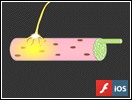Muscles and Motion
Key Questions
-
Muscles are an organ, composed of muscle tissue that contracts to produce a particular movement. Muscles are grouped in different ways.
If they are voluntary , that is we have to think about them, to make them move. Or if they are not, they are involuntary . Lastly, there is cardiac muscle.
As a whole, they make up about 36% of the body. The muscles that you move by thinking are also called skeletal muscles since the use bones as levers. These are all most always in pairs.
The involuntary muscles are found in all hollow organs except for the heart. They move very slowing in a way called peristalsis. These muscles are also called smooth muscles.
Cardiac (heart) muscles pump the heart.
-
Only skeletal muscles work with bones and muscles keep bones in place and also play a role in the movement of bones.
To allow motion, different bones are connected by joints.
A skeletal muscle may attach a bone to another bone (often across a joint) or a bone to another structure, such as skin.
When the muscle contracts, one of the structures usually remains stationary, while the other moves.
When muscles contract, the pull or force, of muscle contraction is applied to levers, such as bones, resulting in movement of those levers.
A lever is a rigid shaft capable of turning about a hinge, or pivot point, called a fulcrum and transferring a force applied at one point along the lever to a weight (resistance) placed at another point along the lever.
The joints function as fulcrums , the bones function as levers , and the muscles provide the pull to move the levers.
Lever are classified as type I, II, or III.
In a class I lever system, the fulcrum is located between the pull and the weight. A child's seesaw is an example of this type of lever. The head is an example of this type of lever in the body.
In a class II lever system, the weight is located between the fulcrum and the pull.
An example is a wheelbarrow; the wheel is the fulcrum and the person lifting on the handles provides the pull. In the body, an example of a class II lever is lifting the heel.In a class III lever system, the most common type in the body, the pull is located between the fulcrum and the weight.
An example is a person using a shovel. The hand placed on the part of the handle closest to the blade provides the pull to lift the weight and the hand placed near the end of the handle acts as the fulcrum.
In the body, the action of the biceps brachii muscle (force) pulling on the radius to flex the elbow and elevate the hand is an example.
-
There are three types of muscles.
There are ones that you have to think about before they will move. These are called voluntary muscles. Some names for these are the biceps (upper arm), masseter (jaw) and quadriceps (upper leg).
There are ones you don't have to think about and these are called involuntary muscles. These are found in all hollow organs.
And lastly, there are ones only found in the heart and these are called cardiac muscles.
All of these muscles use the sliding filament model of contraction. The only difference is in the way that the brain and nervous system interact.


